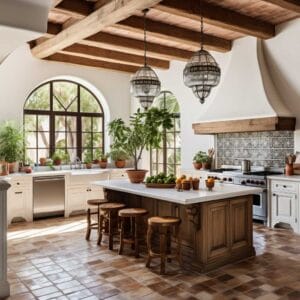Creating a welcoming and stylish drawing room that leaves a lasting impression on your guests starts with the right wall paint design. Modern aesthetics have revolutionized the way we think about interior decor, introducing a plethora of wall paint designs that blend contemporary art with functionality. These designs not only enhance the visual appeal of your drawing room but also reflect your personal style and taste. From bold geometric patterns to subtle textures and innovative color gradients, modern wall paint designs offer endless possibilities to transform your drawing room into a stunning showcase of modern design.
Incorporating Dynamic Stripes and Lines into Drawing Room Wall Paint Design
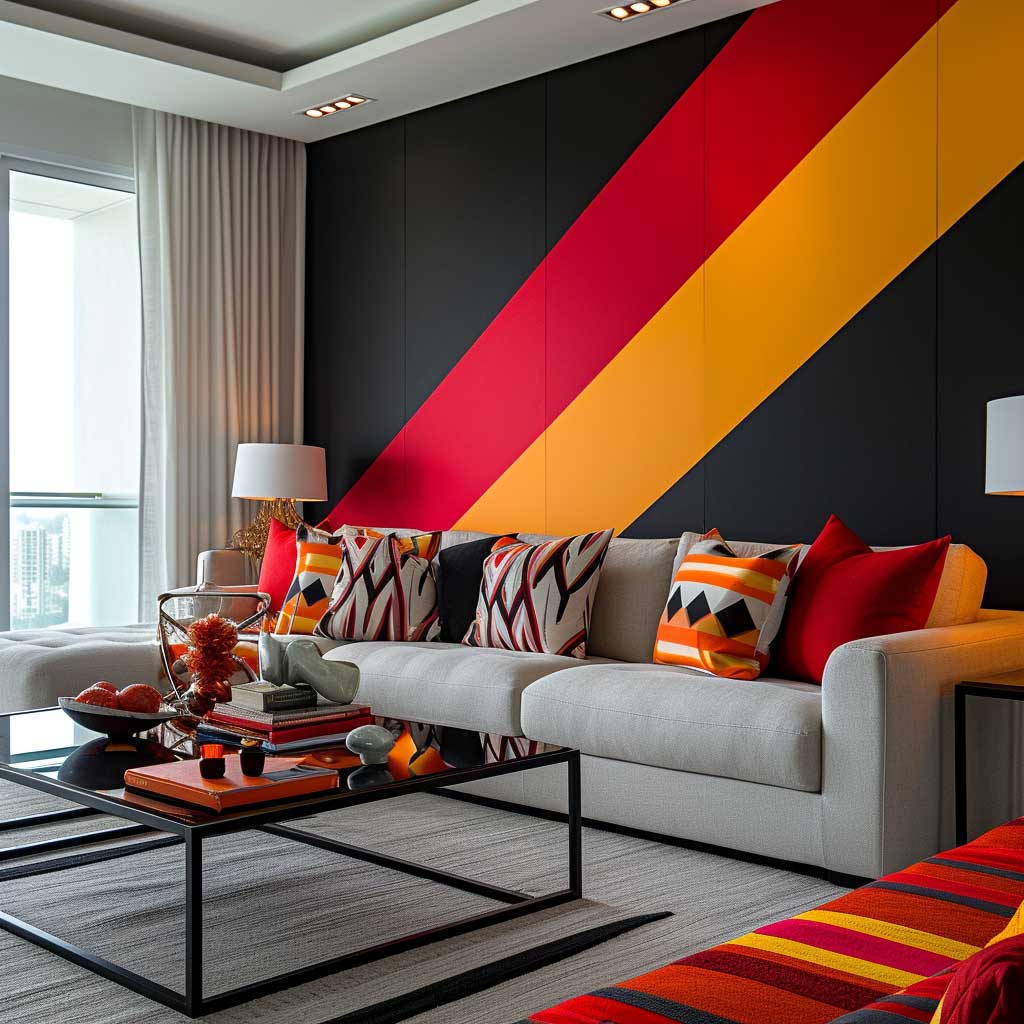

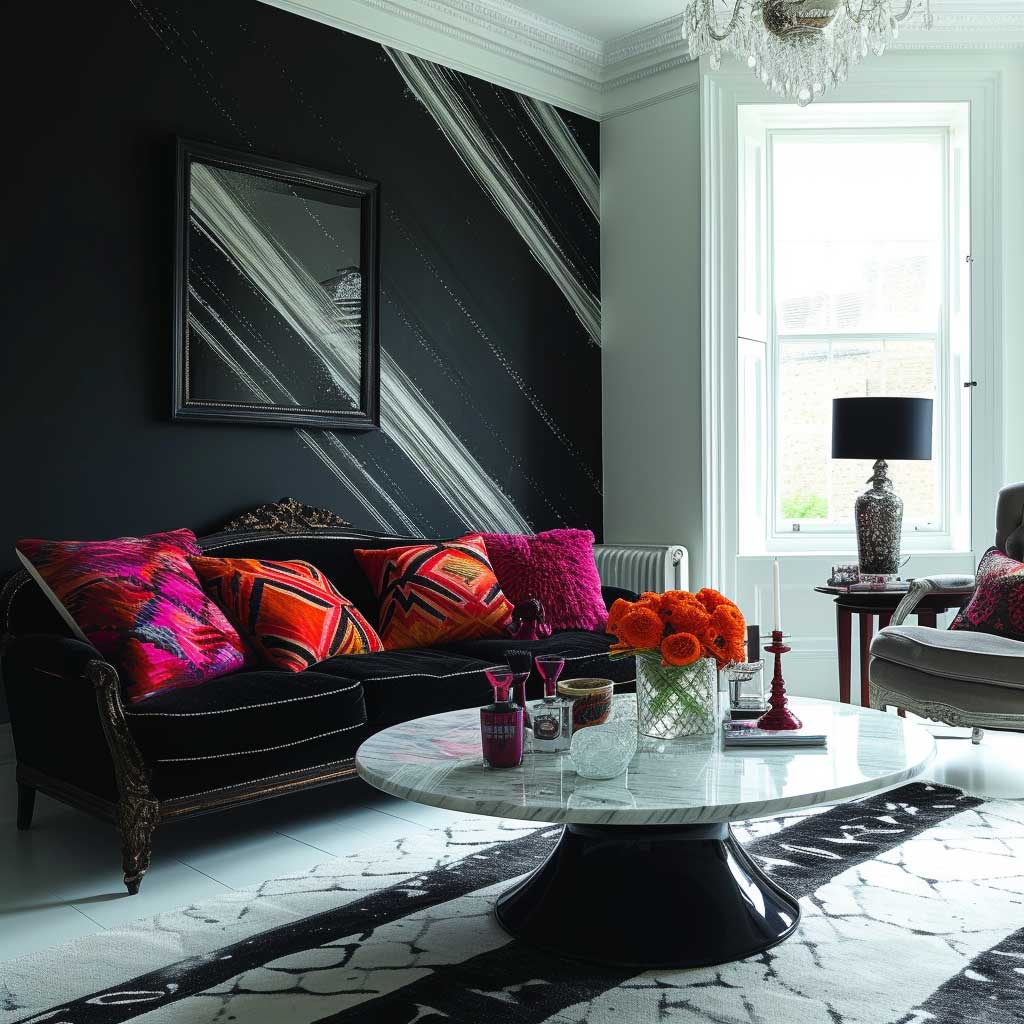

The art of transforming a drawing room into a vibrant and engaging space often begins with the walls. Among the myriad of design options, the use of dynamic stripes and lines in wall paint design stands out for its ability to infuse energy and movement into the room. This approach to drawing room decor is not just about aesthetics; it’s a deliberate choice to create an environment that stimulates conversation and captures the imagination.
Dynamic stripes and lines offer a versatile palette for creativity, allowing homeowners to play with various widths, directions, and colors. The impact of these designs on a room’s atmosphere cannot be understated. They have the power to alter perceptions of space, making rooms appear larger or cozier, depending on the orientation and color scheme used. This transformative ability is what makes stripes and lines a popular choice among interior designers seeking to craft unique and lively drawing room atmospheres.
The application of stripes can range from bold, contrasting colors that make a statement to subtle tonal variations that add depth and texture without overwhelming the space. Vertical stripes are known to elevate the ceiling height visually, creating a sense of spaciousness, while horizontal stripes can make a room feel more expansive. Diagonal lines introduce a dynamic energy, suggesting movement and adding a contemporary edge to the drawing room.
When incorporating stripes and lines into a drawing room wall paint design, the choice of color plays a pivotal role in setting the mood. Warm colors can create a cozy and inviting atmosphere, while cool colors have a calming effect, making the space feel more open and serene. For those looking to add a touch of sophistication, metallic stripes or lines can provide a luxurious feel, reflecting light and adding a layer of elegance.



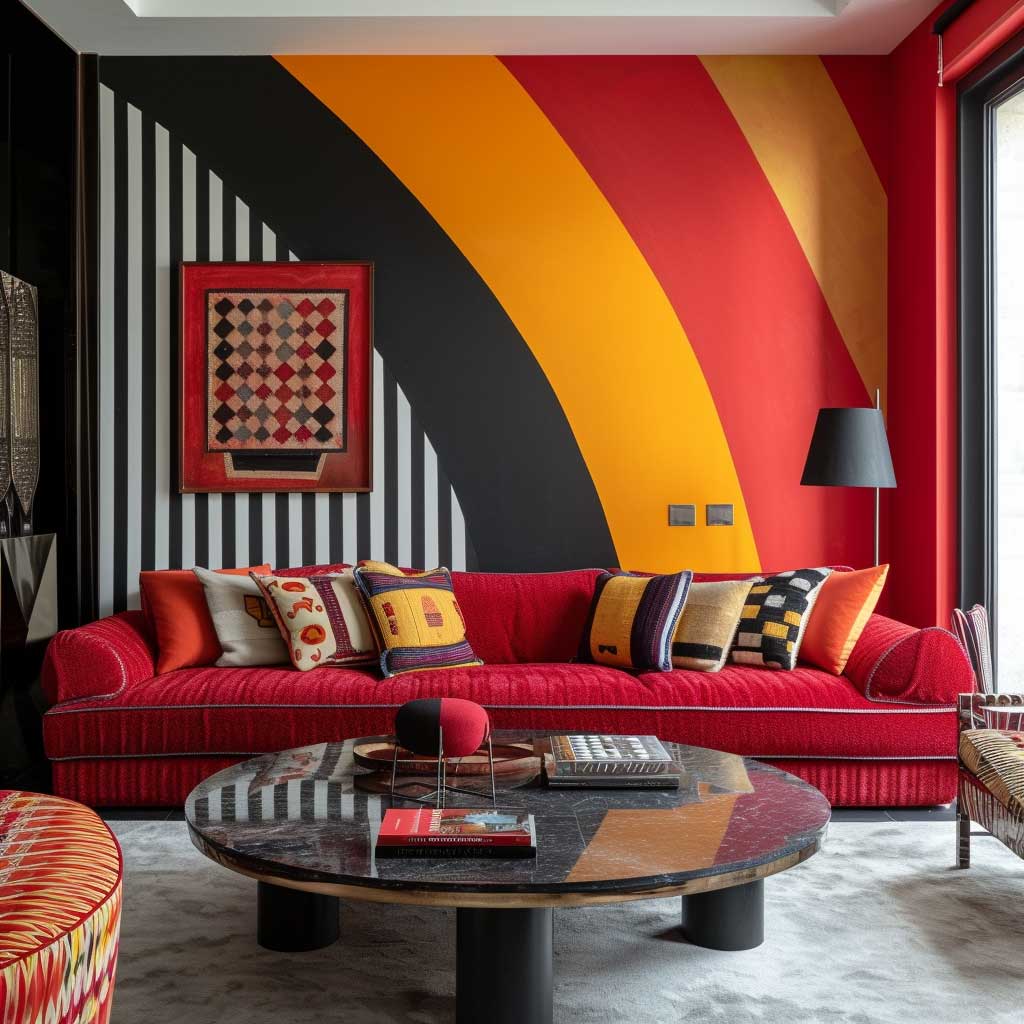
The integration of dynamic stripes and lines into drawing room design is not just about the visual impact. It’s also about how these elements interact with the room’s other components. Furniture, textiles, and artwork can all be chosen to complement or contrast with the wall design, creating a cohesive look that is both stylish and functional. For instance, minimalist furniture and neutral-toned decor can balance the boldness of the walls, ensuring that the room remains a comfortable and welcoming space for guests.
One of the most exciting aspects of using dynamic stripes and lines in drawing room wall paint design is the opportunity for personalization. Homeowners can experiment with different scales, from thin, delicate lines that add a subtle texture to wide stripes that make a bold statement. The direction of the stripes can also be varied, with some walls featuring vertical lines and others adorned with horizontal or diagonal patterns, creating a curated look that reflects the homeowner’s style.
In conclusion, the use of dynamic stripes and lines in drawing room wall paint design offers a creative and effective way to inject life and energy into the space. Whether the goal is to create a focal point, enhance the room’s dimensions, or simply add a layer of visual interest, these designs provide a flexible and stylish solution. By carefully selecting colors, patterns, and complementary decor, homeowners can transform their drawing rooms into lively and inviting spaces that leave a lasting impression on all who enter.
Embracing Abstract Art in Drawing Room Wall Paint Design




In the realm of interior design, the drawing room serves as a canvas for expression, a space where art and functionality meld to create an environment that’s both inviting and intriguing. Incorporating abstract art inspirations into the wall paint design of a drawing room can elevate the aesthetic appeal of the space, turning walls into focal points that captivate and stimulate the imagination of guests. This approach to design is not just about decoration; it’s a bold statement of style that reflects the homeowner’s appreciation for contemporary art and personal expression.
Abstract art, with its emphasis on colors, shapes, and textures rather than on explicit depiction, offers endless possibilities for creative wall designs. The beauty of abstract designs lies in their ability to evoke emotions and create atmospheres without being tied to the literal representation of objects. For a drawing room, this means the opportunity to play with visual dynamics, creating spaces that are not only visually stimulating but also emotionally resonant.
When considering abstract art inspirations for drawing room walls, the choice of colors plays a pivotal role. Vibrant hues can energize the space, making it feel alive and dynamic, while softer, muted tones can create a serene and contemplative atmosphere. The key is to choose a color palette that complements the room’s overall decor and aligns with the desired mood and ambiance.
Texture is another critical element in abstract wall paint designs. Techniques such as sponging, rag-rolling, and stippling can add depth and interest to the walls, creating a tactile experience that enhances the visual impact of the abstract design. These textures can be subtle or pronounced, depending on the desired effect, and can be used to accentuate certain areas of the room or to add a layer of complexity to the overall design.

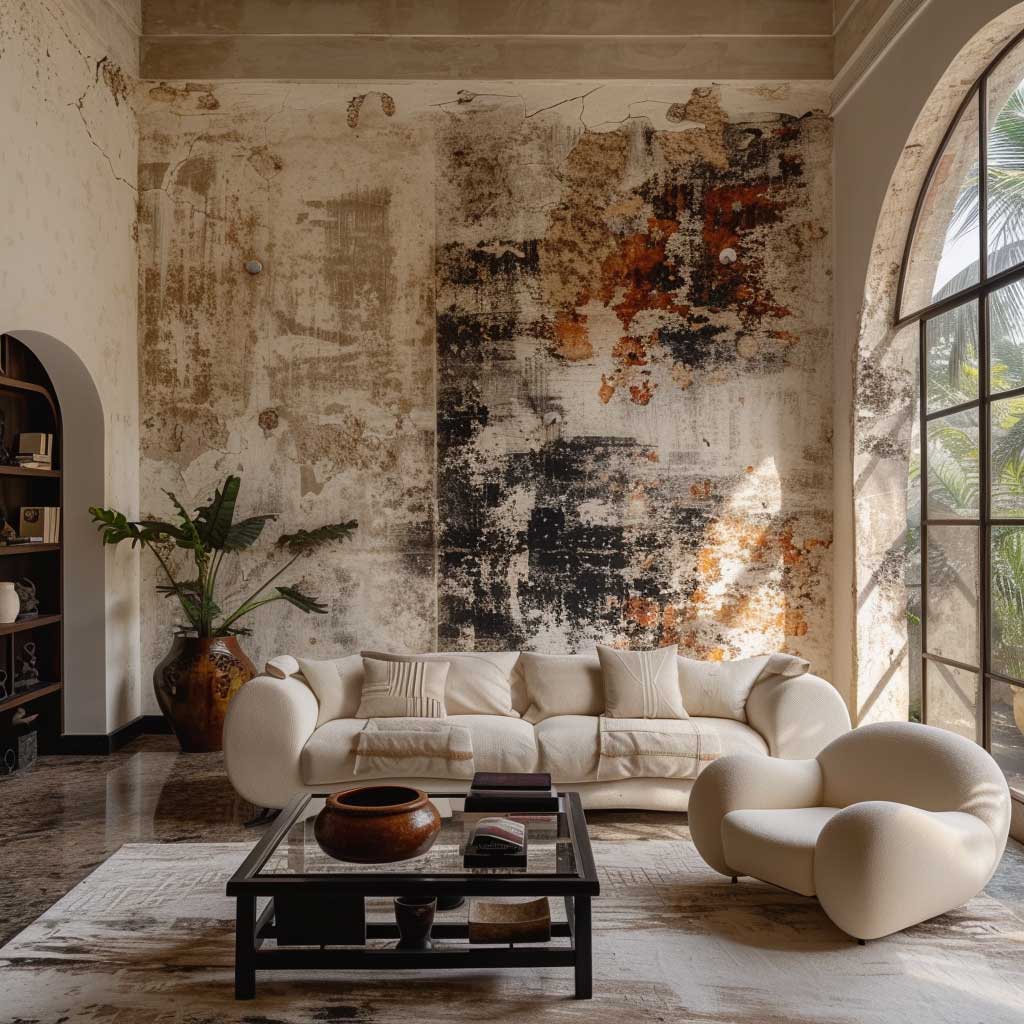
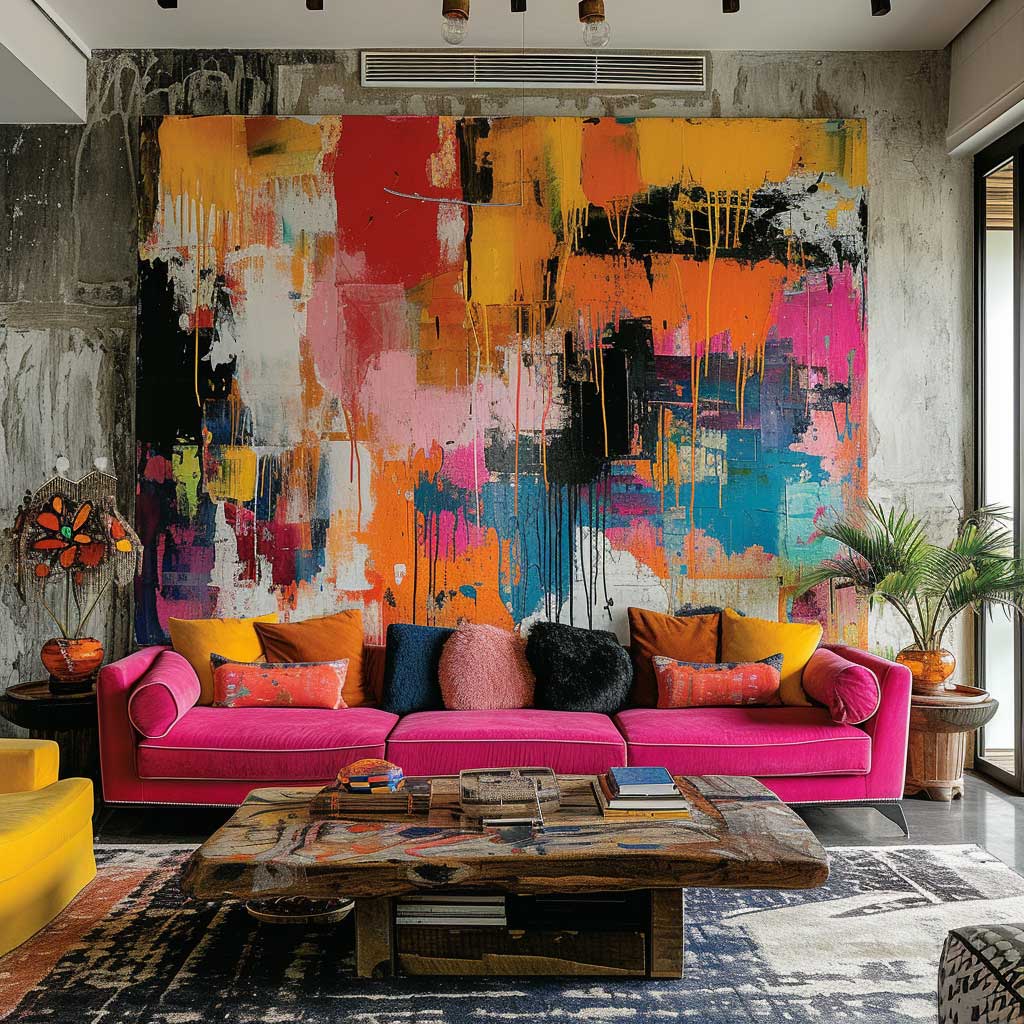

Incorporating geometric shapes and lines is a common approach in abstract art that can be effectively translated into wall paint designs. Geometric patterns can add structure and rhythm to the space, creating a sense of order amidst the abstraction. Whether it’s a series of concentric circles, a grid of squares, or a cascade of triangles, geometric elements can serve as a unifying theme for the room, tying together various design elements.
The integration of abstract art into drawing room wall paint design encourages a playful and imaginative approach to decorating. It invites homeowners and designers to experiment with scale, contrast, and composition, creating unique spaces that reflect a modern and artistic sensibility. Abstract wall designs can also serve as conversation starters, sparking curiosity and dialogue among guests and making the drawing room a truly engaging space.
In conclusion, abstract art inspirations offer a rich source of ideas for drawing room wall paint design, allowing for the creation of spaces that are visually compelling and emotionally evocative. This approach to design celebrates creativity and personal expression, transforming the drawing room into a testament to the homeowner’s taste and artistic vision. By embracing the principles of abstract art, homeowners can craft drawing rooms that are not only beautiful but also deeply reflective of their unique personalities and aesthetic preferences.
Elevating Drawing Room Elegance with Minimalist Monochrome Wall Paint Design


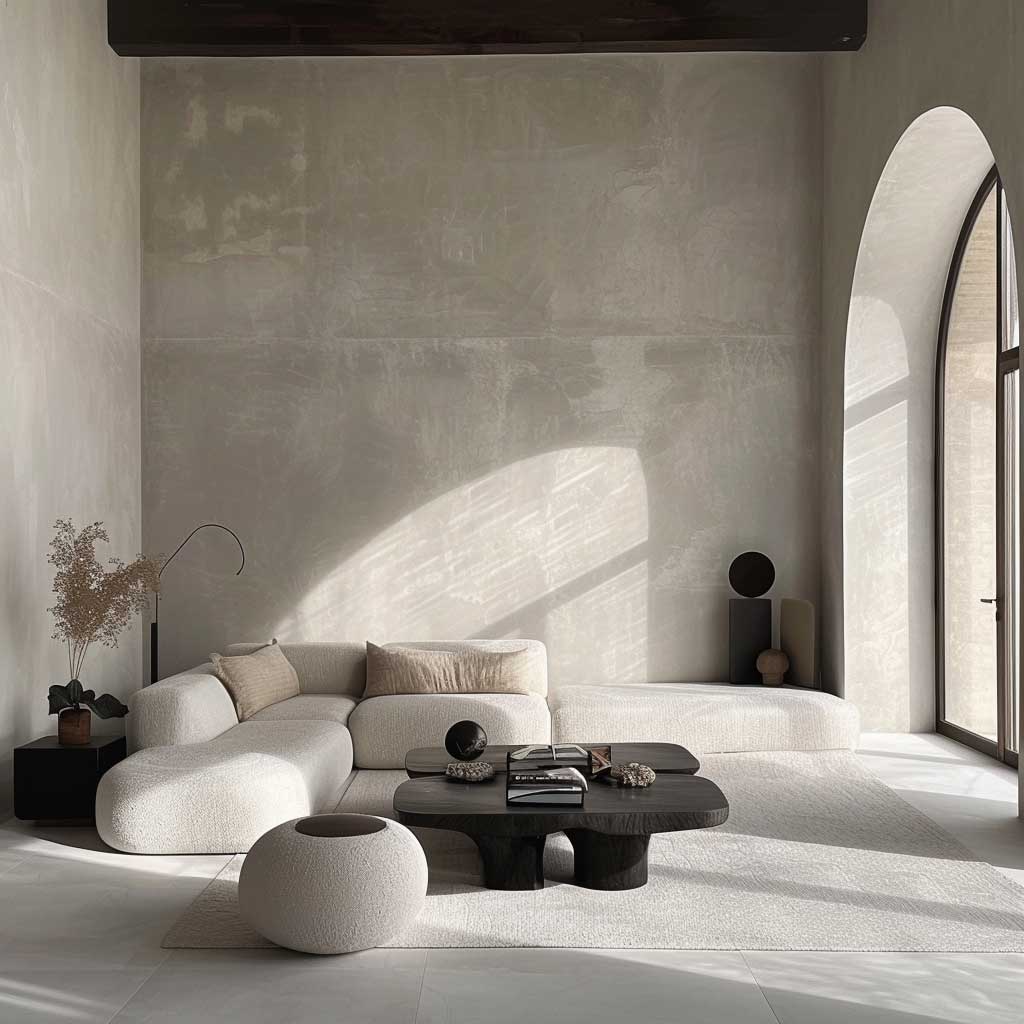

The minimalist monochrome design philosophy represents more than just an aesthetic choice; it’s a statement of simplicity, clarity, and sophistication. In the context of drawing room wall paint design, adopting a minimalist monochrome palette can transform the space into an elegant and timeless sanctuary. This design approach strips away the unnecessary, focusing on the beauty of pure form and the power of a singular color spectrum to define the room’s character.
The essence of minimalist monochrome design lies in its restraint and precision. By choosing a monochromatic color scheme, you create a cohesive and serene environment that allows the architectural features of the room to stand out. The subtlety of varying shades and textures within a single color family adds depth and interest without the need for overt decoration. This simplicity doesn’t equate to starkness; rather, it offers a calm, refined backdrop that enhances the overall sense of space and light in the drawing room.
In implementing a minimalist monochrome wall paint design, the selection of the base color is paramount. Whether it’s a soft, dove gray that evokes a sense of peace and serenity, a warm, creamy white that bathes the room in a gentle glow, or a deep, charcoal black that adds drama and intensity, the chosen hue sets the mood and atmosphere of the space. The key is to layer different shades, tones, and textures of this base color to create a rich, nuanced visual experience that is both dynamic and harmonious.
Textural contrast plays a significant role in monochrome minimalist design. The interplay of matte and glossy finishes, for instance, can introduce a subtle yet impactful visual dialogue within the room. Wall treatments such as plastering techniques, lime washes, or the use of fabric wallpapers add tactile diversity, inviting touch and enhancing the sensory experience of the space. These elements work together to break the monotony, ensuring that the monochrome design feels lively and engaging.




Furnishings and decor in a minimalist monochrome drawing room should embody the principles of simplicity and functionality. Sleek, modern furniture with clean lines and minimal ornamentation reinforces the room’s understated elegance. In keeping with the monochrome theme, pieces are selected for their form and texture rather than their color, contributing to the cohesive aesthetic. Accents, such as metallic fixtures, glass elements, or natural wood details, can add warmth and brightness, providing subtle focal points that draw the eye without overwhelming the space.
The minimalist monochrome approach to drawing room wall paint design is not merely about creating a stylish space; it’s about crafting an environment that reflects a mindful lifestyle and an appreciation for the beauty of simplicity. This design ethos promotes a sense of tranquility and order, making the drawing room not just a place for social interaction, but a haven of calm in the midst of a chaotic world.
In conclusion, embracing minimalist monochrome magic in drawing room wall paint design offers a pathway to creating spaces that are elegant, timeless, and deeply reflective of modern design sensibilities. This approach underscores the power of simplicity in achieving sophistication, transforming the drawing room into a masterpiece of minimalist design that is both visually stunning and emotionally resonant.
Nature-Inspired Murals: Invigorating Drawing Room Walls with Outdoor Essence


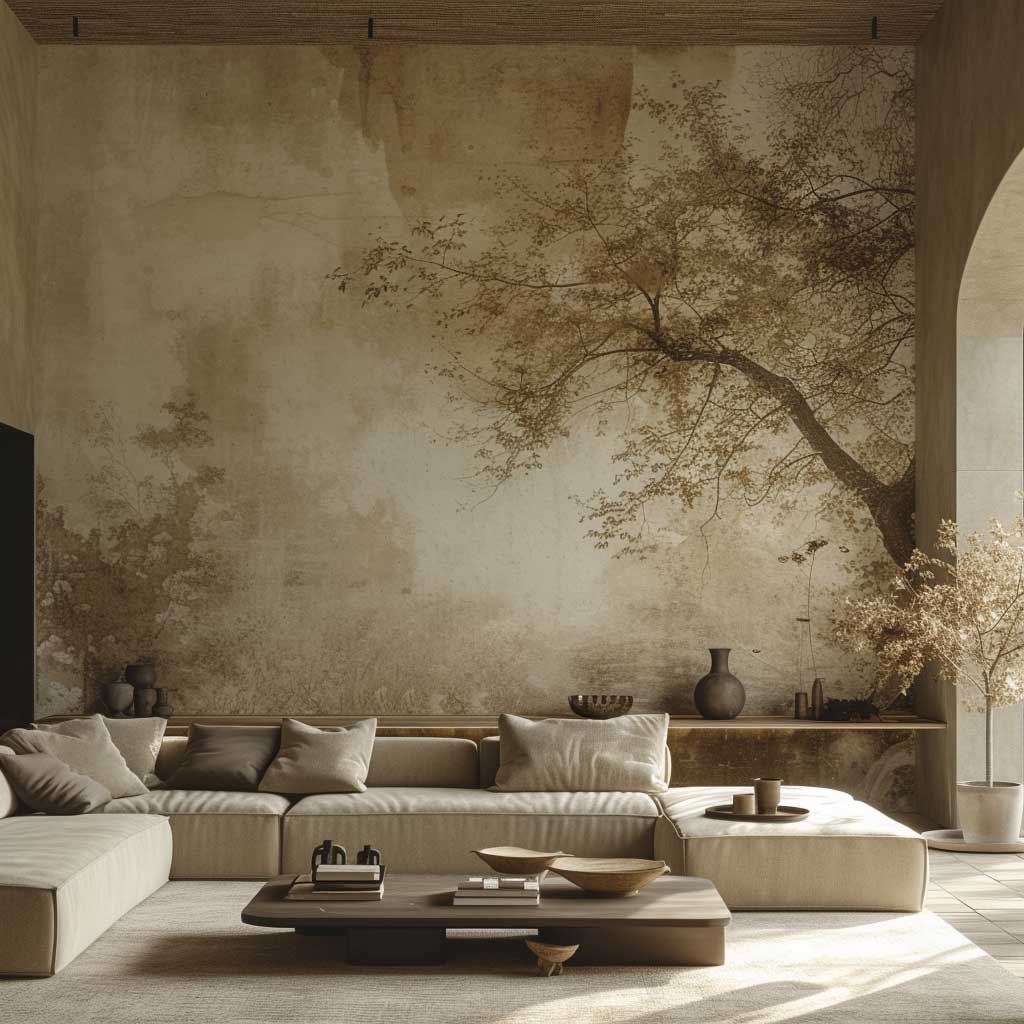

Integrating nature-inspired murals into the design of a drawing room wall paint scheme offers an extraordinary opportunity to blur the lines between the indoors and the great outdoors. This approach not only revitalizes the aesthetic appeal of the space but also taps into the innate human affinity for nature, bringing about a sense of calm and rejuvenation to the home environment. Nature-inspired murals can transform a conventional drawing room into a vibrant sanctuary, echoing the serene beauty of the natural world.
The concept of bringing nature indoors through mural art is not merely a decorative choice; it’s a design strategy that leverages the restorative qualities of natural landscapes to create a more harmonious and uplifting living space. Murals featuring lush forests, tranquil beaches, majestic mountains, or even abstract interpretations of natural elements can dramatically alter the ambiance of a room, making it feel more open, airy, and alive.
Selecting the right mural for a drawing room involves considering the room’s dimensions, lighting, and overall decor theme. A well-chosen mural can become the focal point of the room, setting the tone and mood. For smaller rooms, murals with lighter colors and open landscapes can create an illusion of depth and space. In larger rooms, more detailed and vibrant scenes can add richness and complexity, drawing the viewer in and encouraging contemplation.
The technical execution of nature-inspired murals in drawing rooms also merits careful consideration. Advances in digital printing and painting techniques have made it possible to achieve stunning levels of detail and realism, allowing for custom designs that perfectly fit the space and the homeowner’s vision. Whether hand-painted by an artist or digitally printed onto wallcoverings, the mural should be crafted with precision and care, ensuring that the beauty of the artwork is preserved over time.
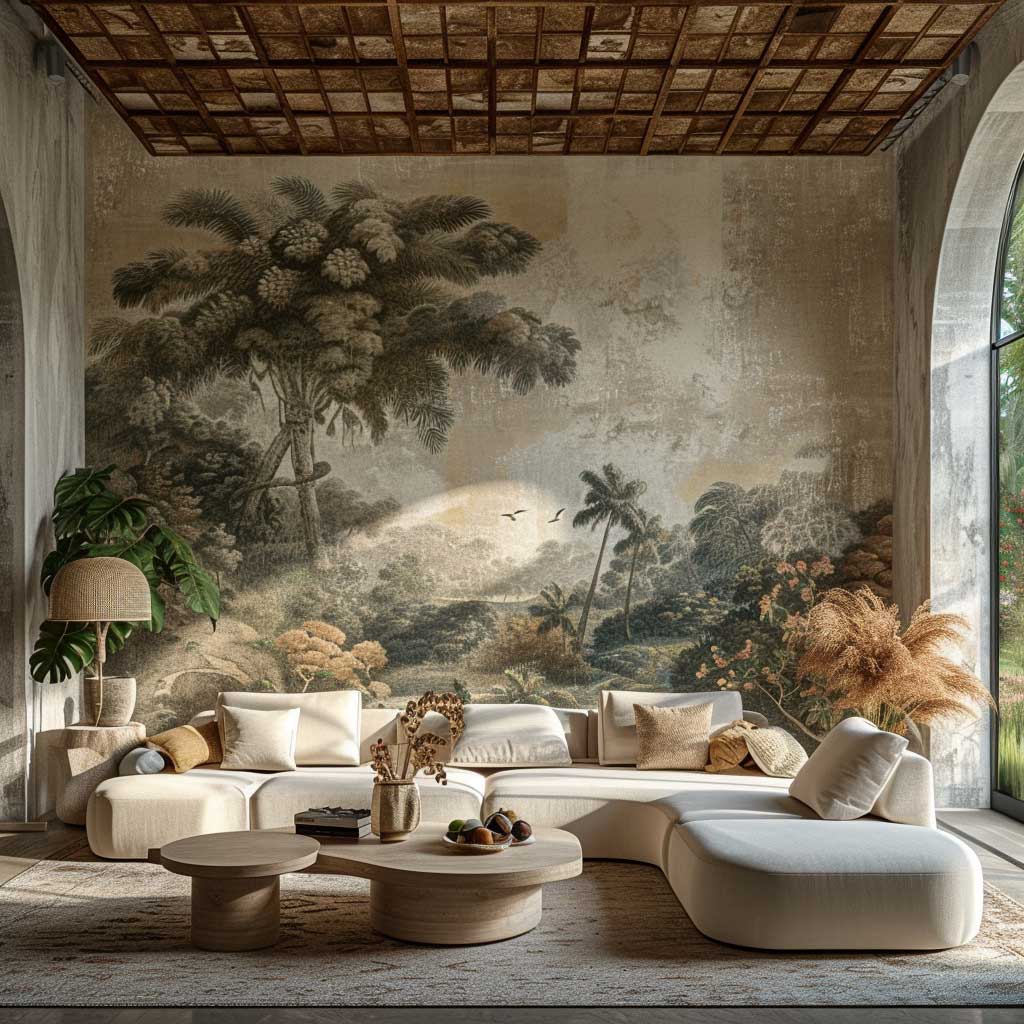
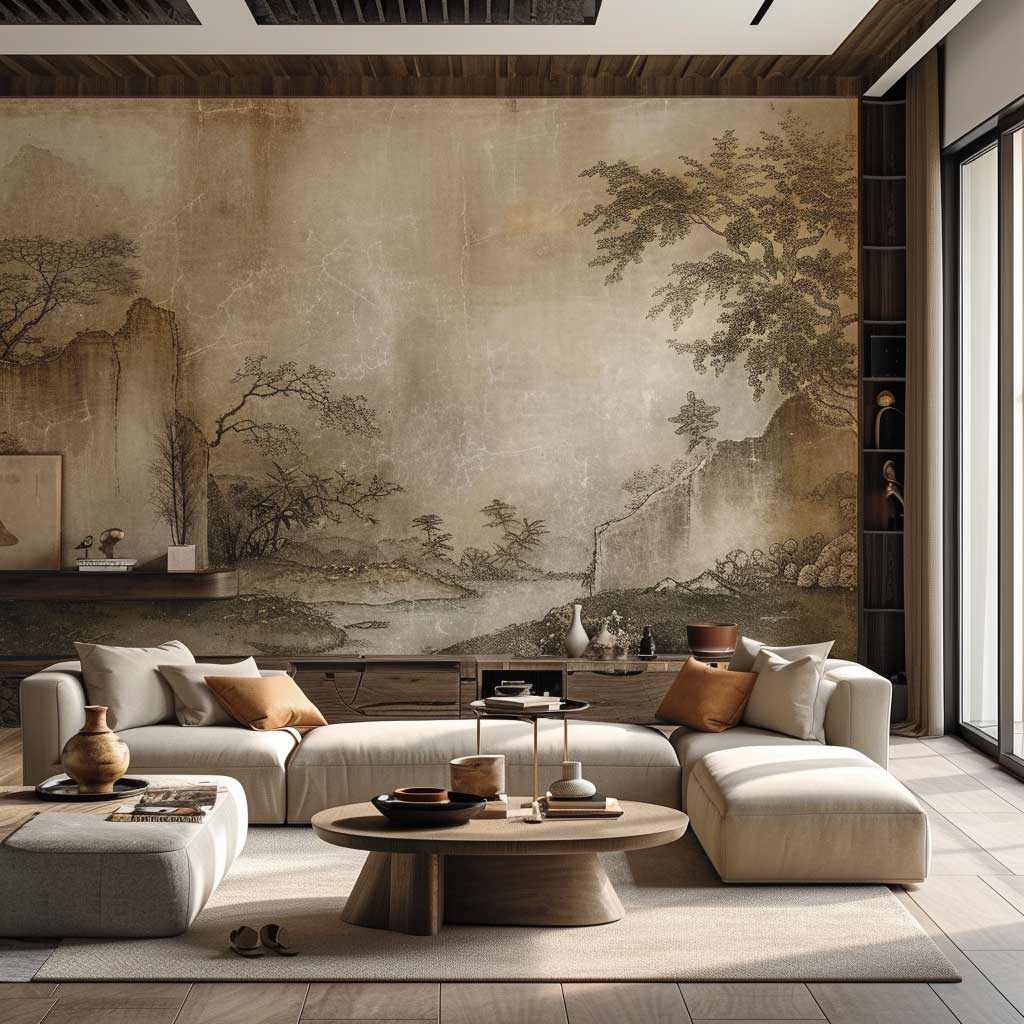

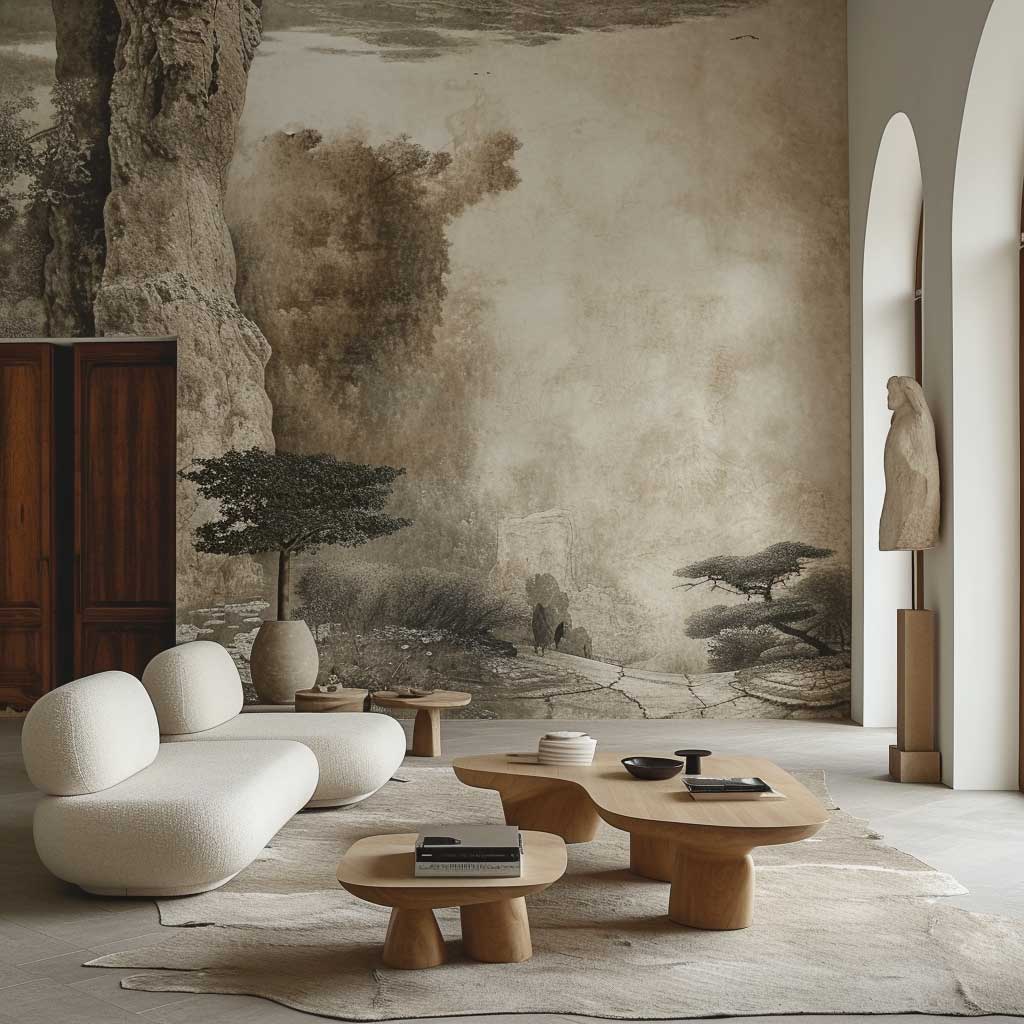
Complementing nature-inspired murals with the right furniture and accessories is key to creating a cohesive interior design. Natural materials such as wood, stone, and linen can harmonize with the mural, enhancing the organic feel of the room. Minimalist furniture and decor can prevent the space from feeling cluttered, allowing the mural to take center stage. The incorporation of indoor plants and natural light can further reinforce the connection to nature, making the drawing room a truly restorative space.
The psychological benefits of incorporating natural elements into interior design are well-documented. Nature-inspired murals can have a calming effect, reducing stress and enhancing well-being. This connection to nature, known as biophilia, underscores the importance of integrating natural beauty into our living spaces, fostering a deeper appreciation for the environment and improving our quality of life.
In conclusion, nature-inspired murals offer a powerful design solution for drawing rooms, capable of transforming ordinary walls into breathtaking landscapes that captivate and inspire. This approach not only elevates the aesthetic quality of the room but also enhances the emotional and psychological experience of the space. By inviting the essence of nature into our homes, we create environments that nurture the soul, affirming the profound connection between human well-being and the natural world.
Infusing Luxury with Metallic Accents in Drawing Room Wall Paint Design
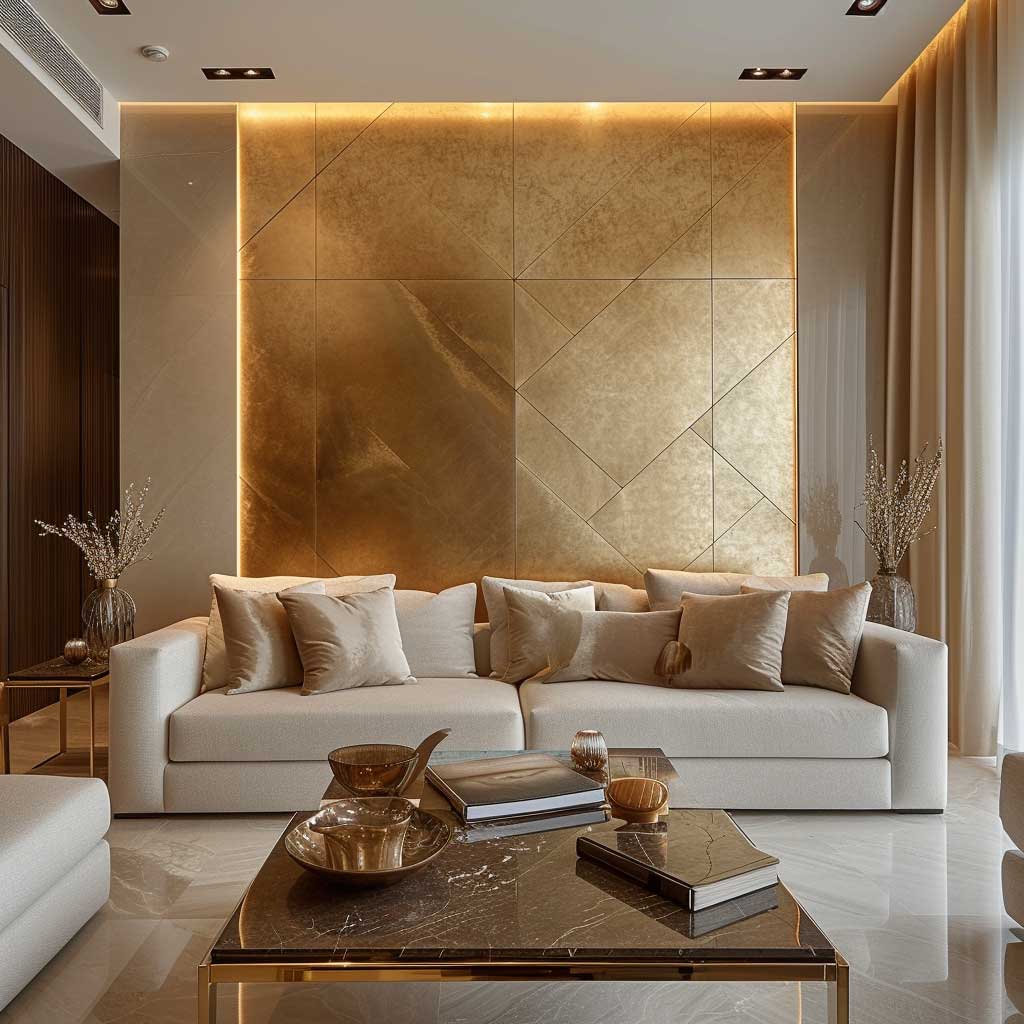
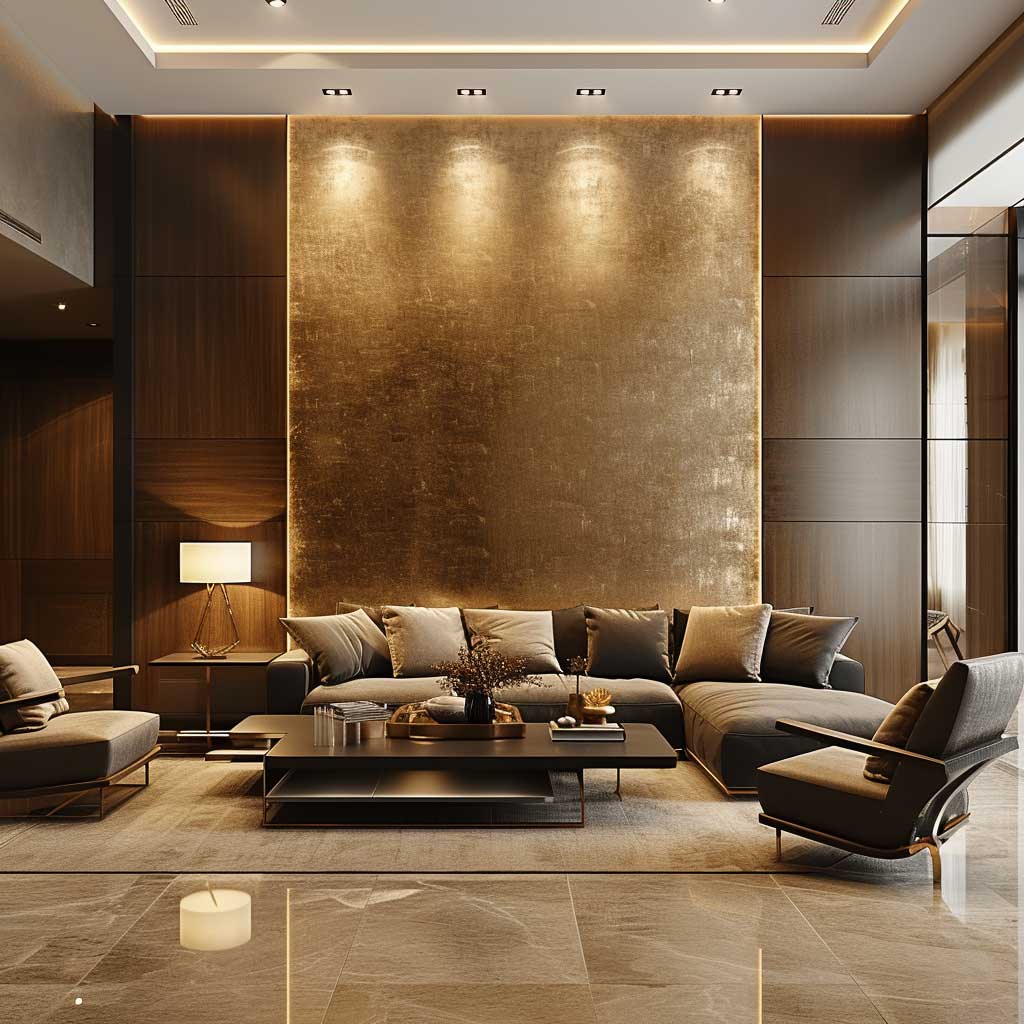


The allure of metallic accents in the realm of interior design lies in their unparalleled ability to inject a room with a sense of sophistication and glamour. When applied to drawing room wall paint designs, metallic elements can transform a space, elevating it from ordinary to extraordinary. This essay explores how integrating metallic accents into drawing room walls can create a luxe atmosphere, making the space not only a place of gathering but also a showcase of refined taste.
Metallic tones, such as gold, silver, bronze, and copper, bring warmth, depth, and texture to a room. Their reflective properties can brighten a space, catching and bouncing light around the room to create a dynamic interplay of luminosity and shadow. This effect can make the drawing room feel more vibrant and alive, an ideal setting for both relaxed conversations and lively gatherings.
Incorporating metallic accents into a drawing room’s wall paint design requires a thoughtful approach to balance and harmony. One method is to use metallic paint as a highlight, accentuating architectural features like moldings, cornices, or ceiling roses. This subtle application can draw attention to the craftsmanship of the space while adding a layer of sophistication. Alternatively, metallic wallpapers with patterns or textures offer a more impactful statement, creating a focal wall that captivates and intrigues.
The choice of metallic tone should complement the overall color scheme and decor style of the drawing room. Warm metallics, such as gold and copper, pair beautifully with rich, deep colors like navy or burgundy, creating a cozy yet opulent atmosphere. In contrast, cool metallics like silver and pewter work well with lighter, airy colors, lending a modern, sleek look to the space.


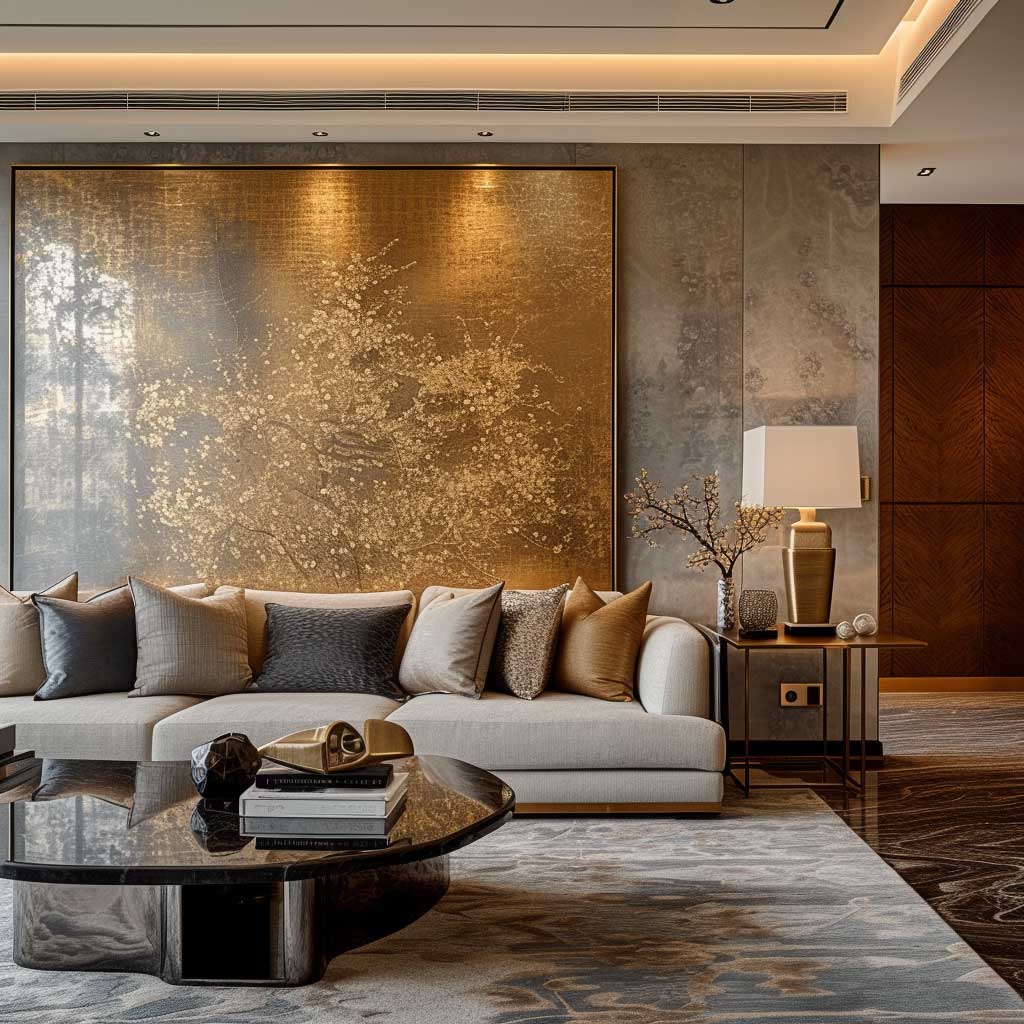

Beyond aesthetics, the use of metallics in wall paint design can also influence the perceived size and shape of a drawing room. Reflective surfaces can make a small room appear larger and more open, while the strategic placement of metallic accents can guide the eye, altering the room’s perceived proportions and focus points.
The integration of metallic accents extends beyond paint and wallpaper. Accessories and furnishings with metallic finishes can further enhance the luxe look, creating a cohesive and harmonious design. From mirror frames and light fixtures to decorative objects and furniture detailing, these elements can reinforce the luxurious feel of the drawing room.
Achieving a luxe look with metallic accents in a drawing room also involves layering textures and materials. Combining smooth, glossy metallics with softer, matte finishes can add depth and interest to the space. This contrast of textures enriches the sensory experience of the room, making it not only visually appealing but also tactilely engaging.
In conclusion, metallic accents offer a powerful tool in the creation of luxurious and sophisticated drawing rooms. Their reflective beauty and warmth can transform a space, infusing it with glamour and elegance. By carefully selecting metallic tones and balancing them with the overall design of the room, homeowners and designers can craft drawing rooms that are not only visually stunning but also rich in character and style. This approach to wall paint design celebrates the art of refinement, creating spaces that are both inviting and impressive.
Sophisticated Gradients: A New Dimension in Drawing Room Wall Paint Design
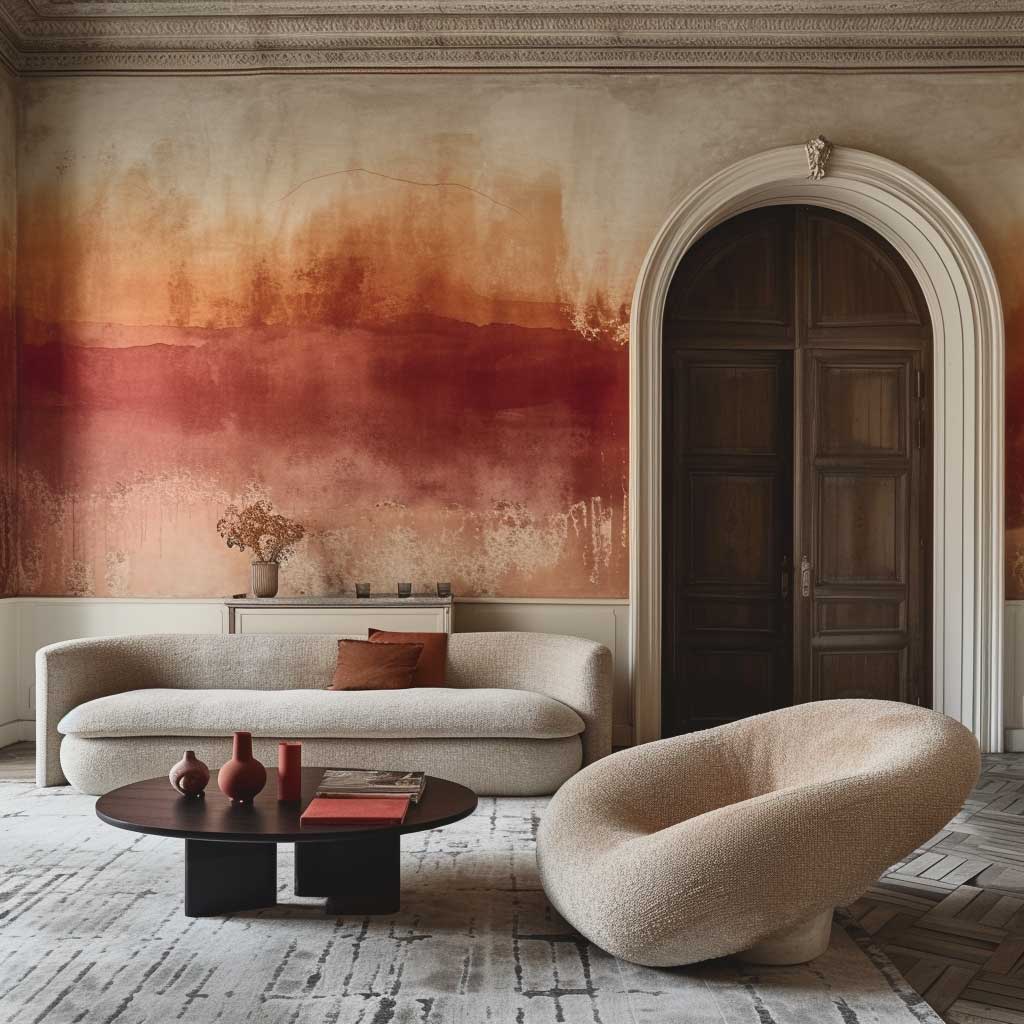

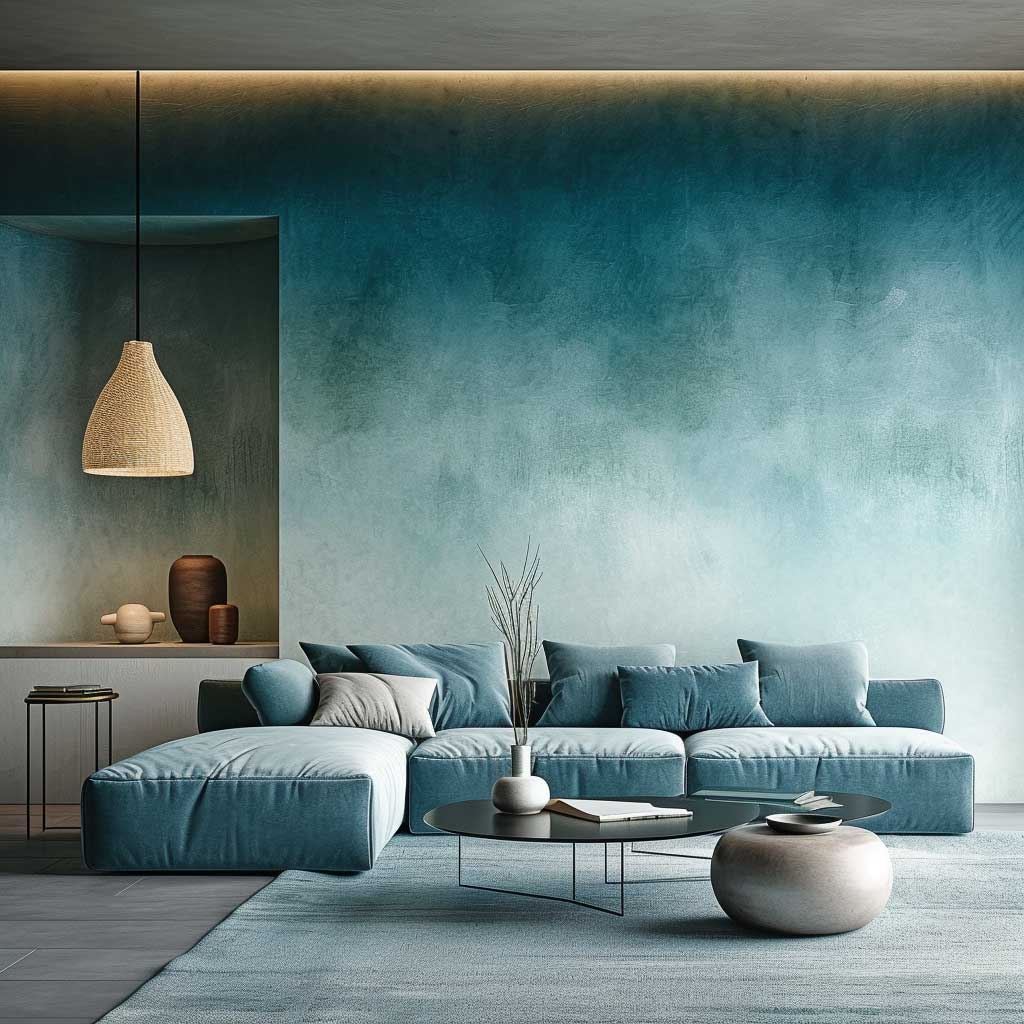

In the dynamic world of interior design, the introduction of sophisticated gradients in drawing room wall paint designs marks a captivating evolution from traditional solid colors to more complex and engaging visual experiences. This essay delves into how gradients, with their seamless transition from one hue to another, can elevate the aesthetics of drawing rooms, creating spaces that are not only visually stunning but also imbued with depth and emotion.
The essence of gradient wall paint design lies in its ability to introduce a sense of movement and fluidity into a room. Unlike the static nature of single-color walls, gradients suggest a narrative, a gentle unfolding of color that can mimic the natural progression of the sky at dawn or dusk, or the deepening hues of the ocean. This subtle yet powerful design element can transform a drawing room from a mere sitting area into a dynamic canvas that reflects the complexities of the natural world.
Implementing sophisticated gradients in a drawing room requires a nuanced understanding of color theory and a skilled hand. The choice of colors is crucial; they must complement each other and the room’s overall palette, ensuring a harmonious transition that enhances the space’s ambiance. The gradient can range from subtle, with closely related shades, to bold, with contrasting colors that make a dramatic statement. The direction of the gradient also plays a significant role, with vertical transitions adding height to a room and horizontal ones expanding the space’s perceived width.
The technical execution of gradient wall paint involves careful planning and precision. The blending of colors must be seamless, with no visible lines or abrupt changes. This can be achieved through various techniques, including airbrushing or using soft brushes and sponges to gently merge the hues. The result is a wall that captivates the eye, inviting viewers to lose themselves in the depths of the design.
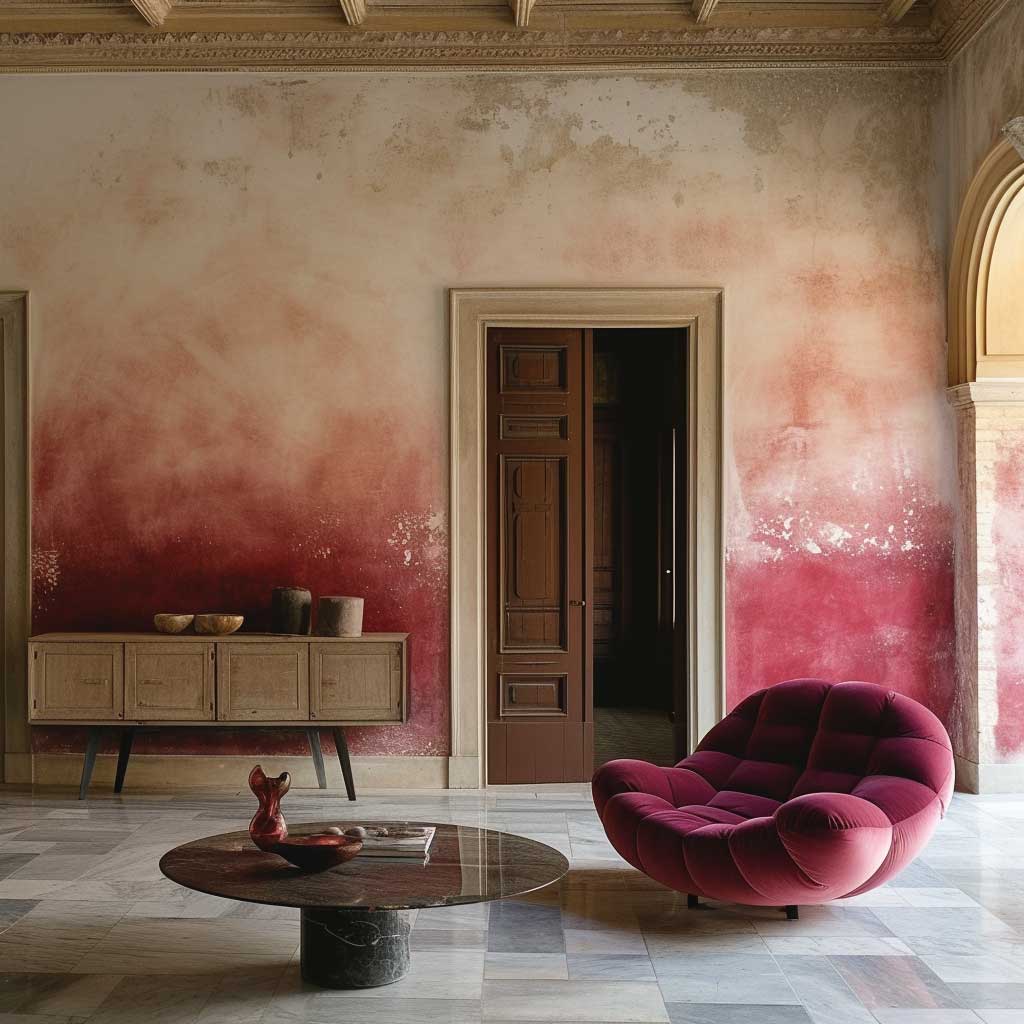

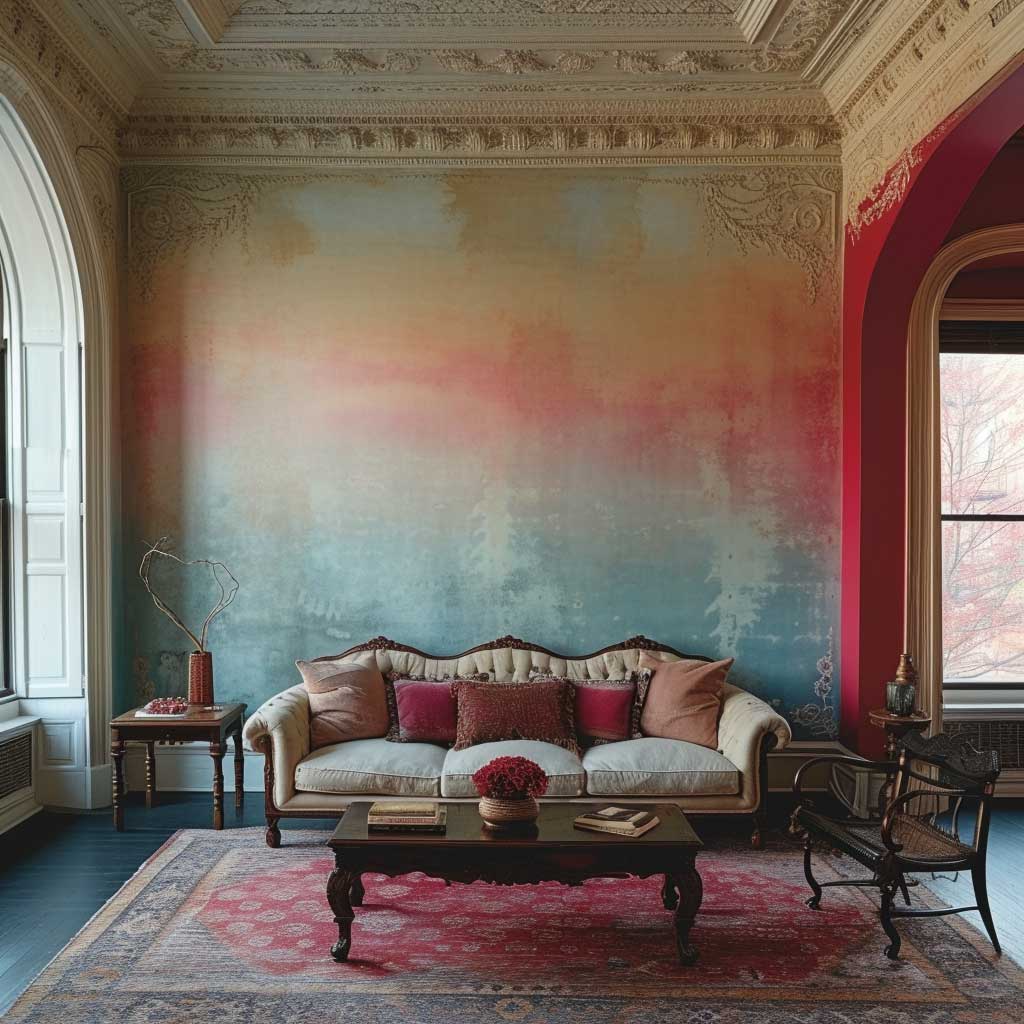

Sophisticated gradients not only add visual interest to drawing rooms but also affect the room’s mood and atmosphere. Cooler gradients, for instance, can create a calming, serene environment, while warmer gradients evoke warmth and energy. The interplay of light and color can also amplify the gradient effect, with natural sunlight or strategic artificial lighting accentuating the colors’ transition, adding a dynamic element that changes throughout the day.
Incorporating gradients into drawing room design also offers an opportunity to experiment with textures and finishes. A matte finish can provide a soft, understated look, while a glossy finish can enhance the gradient’s fluidity, making the colors appear more vibrant and alive. This versatility makes sophisticated gradients a powerful tool in the designer’s arsenal, capable of creating a wide range of effects from subtle elegance to bold drama.
In conclusion, the use of sophisticated gradients in drawing room wall paint designs represents a bold step forward in interior design. This innovative approach adds a new dimension to room aesthetics, transforming walls into works of art that engage and inspire. By carefully selecting colors, employing precise techniques, and considering the interplay of light and texture, designers can harness the power of gradients to create drawing rooms that are not only beautiful but also emotionally resonant and deeply personal.
Elevating Interiors with Elegant Texture Overlays in Drawing Room Design




In the sophisticated realm of interior design, the walls of a drawing room serve not just as boundaries but as canvases for artistic expression. Incorporating elegant texture overlays into the design of drawing room walls represents a nuanced approach that merges the tactile with the visual, offering a depth of complexity that elevates the room’s aesthetic. This essay explores the transformative impact of texture overlays on drawing room walls, crafting spaces that are as visually compelling as they are inviting.
The allure of texture overlays lies in their ability to introduce dimension and character to a room. Unlike flat, monochromatic paint jobs, textured walls catch the light and cast shadows, creating a dynamic interplay that changes throughout the day. From the subtle brushstrokes of lime washes to the bold relief of plaster techniques, texture overlays can range from the understated to the dramatic, offering endless possibilities for customization and expression.
Selecting the right texture for a drawing room is an exercise in balance and harmony. The texture should complement the room’s overall design theme, whether it’s the sleek minimalism of a contemporary space or the warm comfort of a traditional setting. For modern interiors, geometric patterns or abstract reliefs can add a touch of sophistication, while classic interiors may benefit from the richness of old-world plaster techniques or the gentle undulation of hand-troweled finishes.
The application of texture overlays requires a skilled hand and an eye for detail. Techniques vary widely, from the application of specialty plasters and stuccos to the use of textured wallpapers and fabric wall coverings. Each method offers its unique aesthetic and tactile qualities, allowing designers to tailor the texture to the specific needs and preferences of the homeowner.

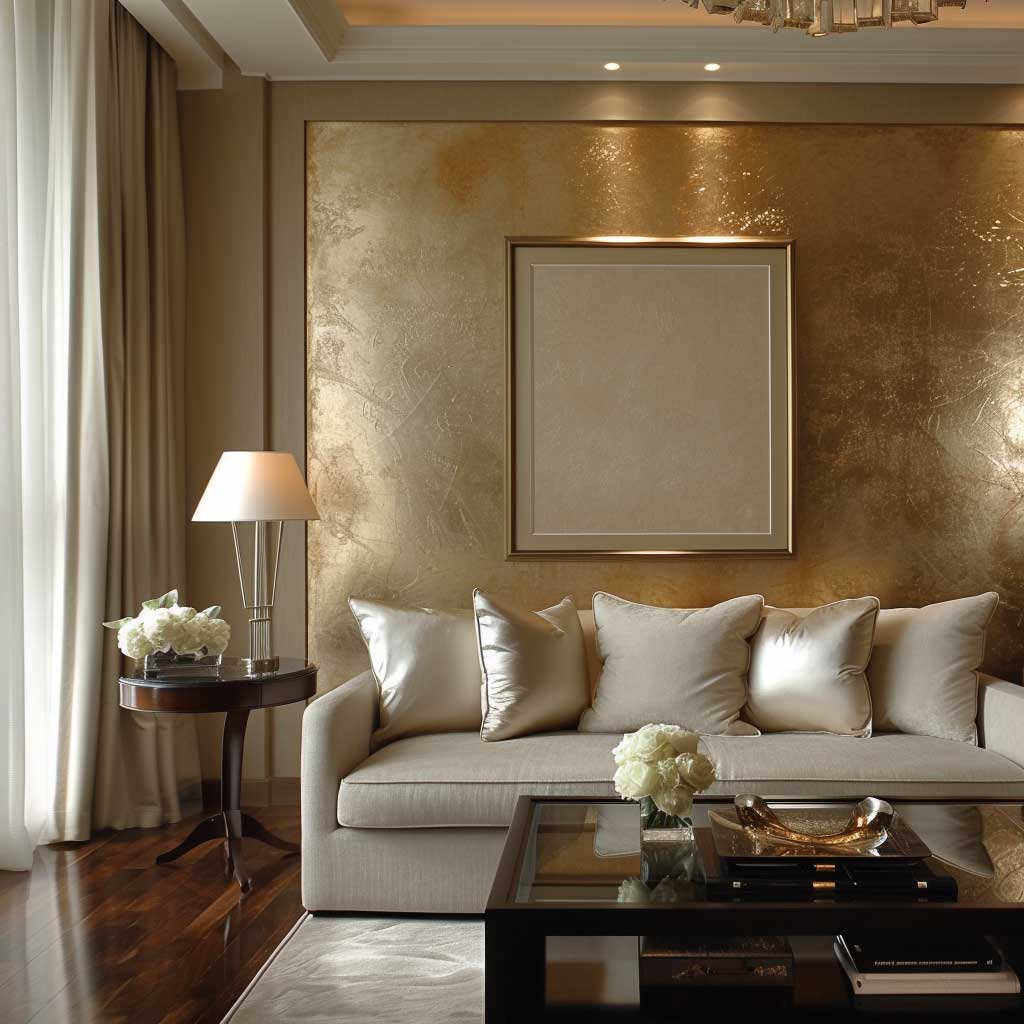


Texture overlays also play a significant role in the sensory experience of a room. They invite touch, encouraging a physical connection with the space that flat walls cannot provide. This tactile engagement adds a layer of intimacy to the drawing room, making it feel more personal and lived-in. Furthermore, the visual warmth of textured walls can make a room feel more welcoming, enhancing the sense of comfort and belonging.
Incorporating texture into drawing room walls also offers practical benefits. Textured surfaces can hide imperfections and wear, making them ideal for high-traffic areas. They can also improve acoustics, absorbing sound and reducing echo in spacious rooms. This functional aspect, combined with the aesthetic appeal, makes texture overlays a smart choice for drawing room design.
Complementing textured walls with the right decor is key to creating a cohesive look. Furnishings and accessories should balance the visual weight of the walls, with smooth, sleek surfaces offering a counterpoint to the texture. In contrast, rich fabrics and natural materials can enhance the tactile quality of the room, creating a layered, multidimensional space that appeals to all the senses.
In conclusion, elegant texture overlays offer a sophisticated tool for enhancing the walls of a drawing room. By adding depth, character, and tactile appeal, textured walls transform the space into an artistic statement that reflects the homeowner’s style and the designer’s vision. Whether aiming for subtle elegance or dramatic flair, texture overlays can elevate the drawing room from a mere functional space to a chic and inviting sanctuary.
Revolutionizing Drawing Room Aesthetics with Bold Color Blocks
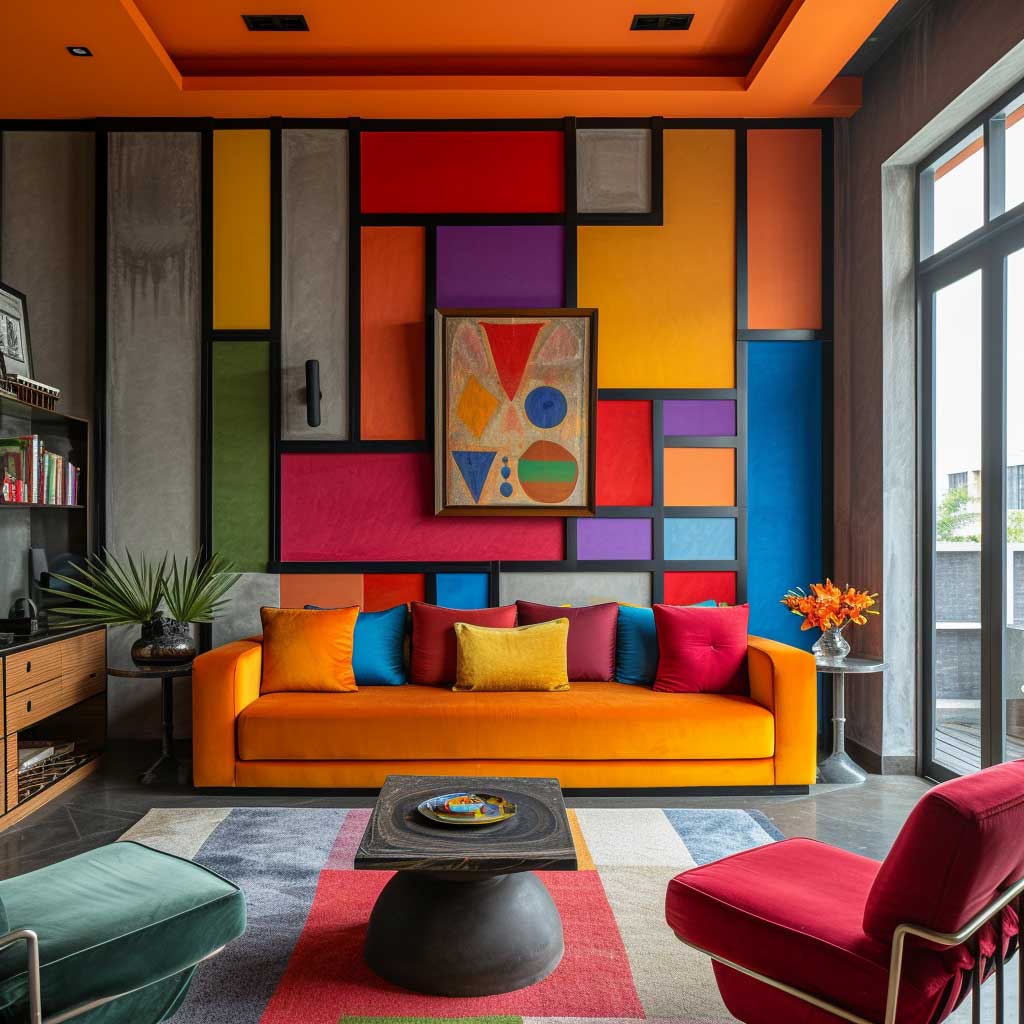

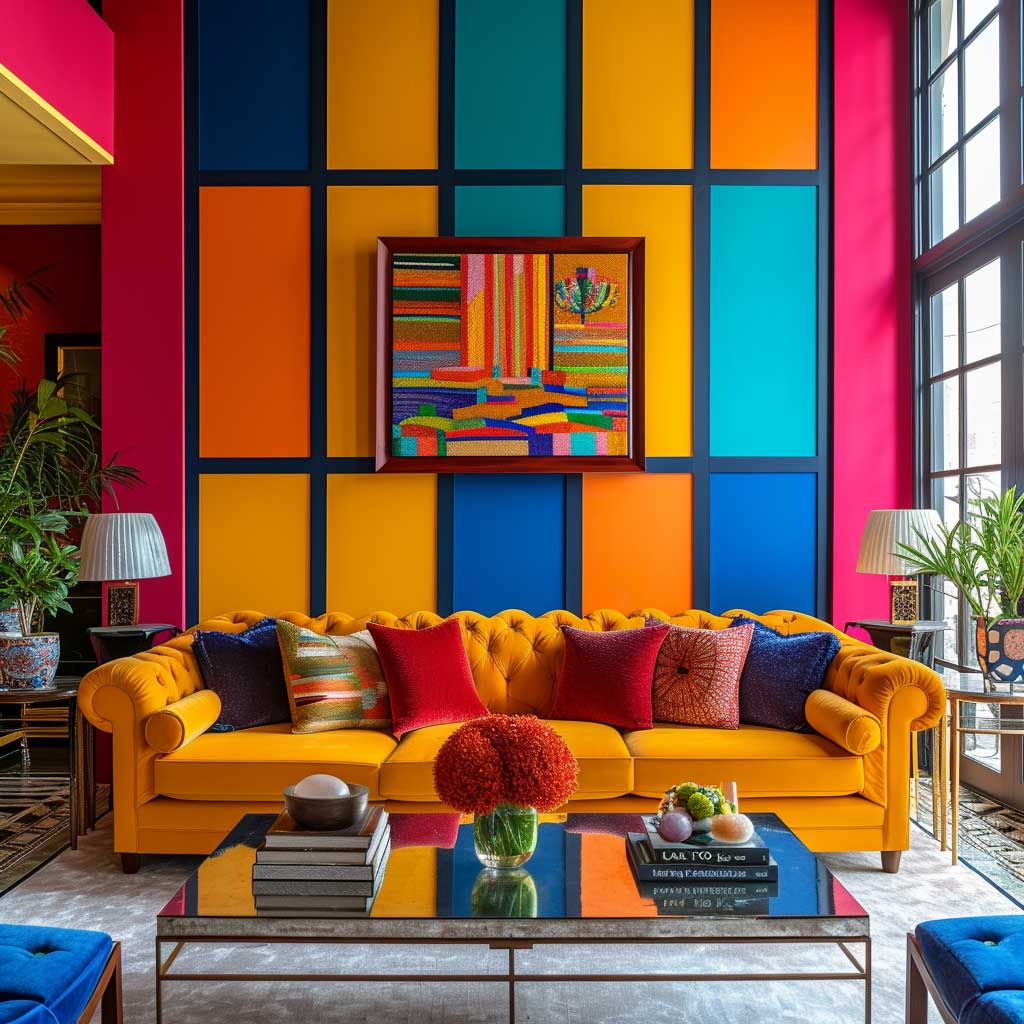

The transformative power of color in interior design is unparalleled, especially when it comes to the bold use of color blocks in drawing room spaces. This essay delves into how integrating bold color blocks into drawing room wall paint designs can revolutionize the aesthetic appeal of these spaces, turning them into vibrant showcases of personality and style. The technique of color blocking—using distinct blocks of color to create striking visual contrasts—can dramatically alter the ambiance of a room, making it more lively, dynamic, and engaging.
Color blocking in drawing room design is not merely a trend; it’s a bold statement of creativity and confidence. It allows for the exploration of color theory in ways that can emphasize architectural features, delineate spaces, or simply bring an element of surprise and delight to the interior landscape. This approach goes beyond traditional paint schemes, offering a playful interaction between color and space that can challenge and redefine conventional aesthetics.
The choice of colors for blocks is critical and should be informed by the desired mood and atmosphere of the room, as well as the existing decor and natural light. Vibrant hues can energize a space, making it feel more open and inviting, while deeper tones can add sophistication and depth, creating a more intimate setting. The juxtaposition of contrasting colors can also highlight or downplay specific features of the room, drawing attention to art, furniture, or architectural details.
Implementing bold color blocks requires a thoughtful consideration of balance and proportion. The size and placement of color blocks can influence the room’s perceived dimensions, with larger blocks making a bold statement and smaller blocks serving as accents. Strategic placement can guide the eye, enhance spatial flow, or even alter the room’s apparent proportions. The key is to achieve a harmonious balance that enhances, rather than overwhelms, the room’s overall composition.


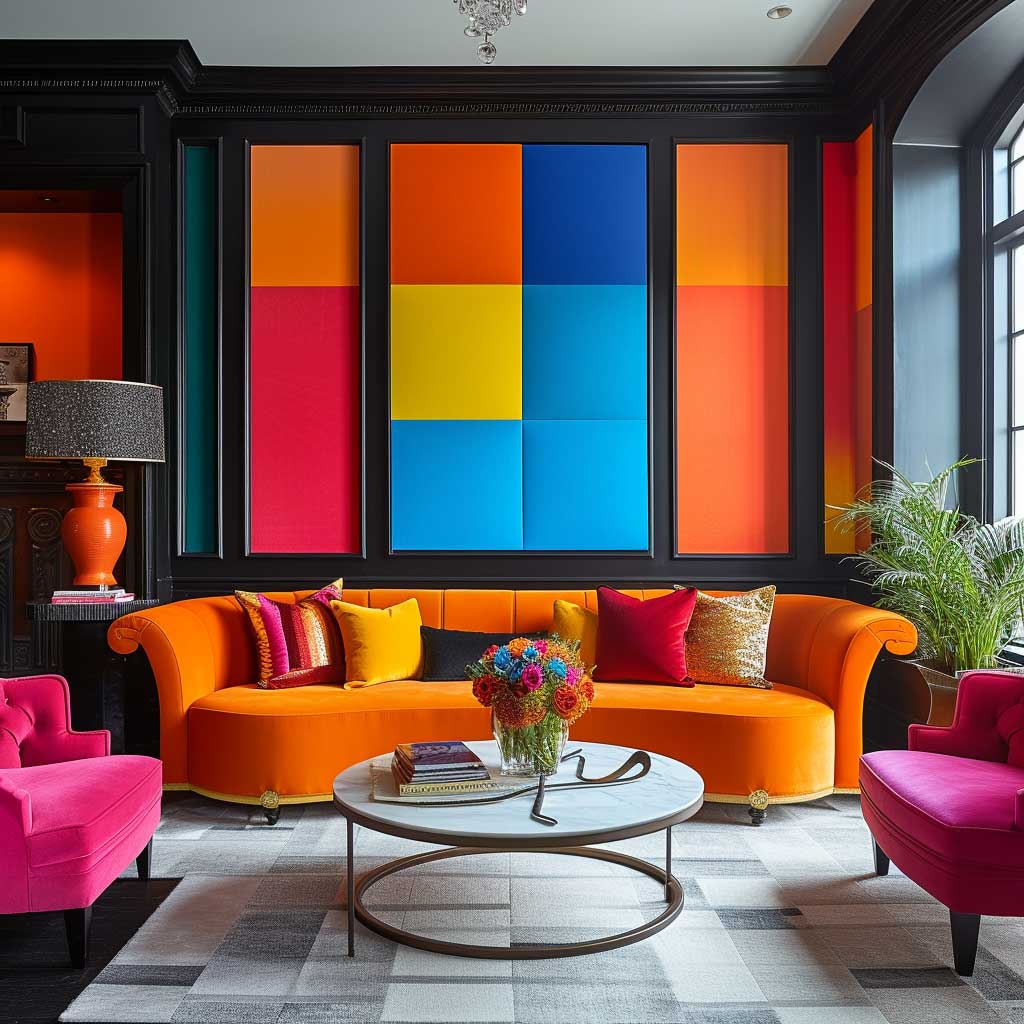

Incorporating color blocks into a drawing room also offers an opportunity to experiment with textures and finishes. Matte finishes can lend a sophisticated, understated look, while glossy finishes can add depth and vibrancy, enhancing the visual impact of the colors. Additionally, integrating materials such as wood, metal, or fabric within color-blocked areas can add another layer of interest and complexity to the design.
The furniture and decor that accompany bold color blocks in a drawing room should complement and enhance the color scheme. Neutral-toned furnishings can provide a calming balance to vibrant walls, while colorful pieces can create a cohesive look that ties the room together. The goal is to create a space that feels intentional and curated, where every element contributes to a unified aesthetic vision.
In conclusion, the use of bold color blocks in drawing room designs represents a dynamic and innovative approach to interior decoration. It challenges traditional norms and invites homeowners and designers to embrace a more adventurous palette. By thoughtfully selecting colors, balancing proportions, and integrating textures and materials, color blocking can transform a drawing room into a captivating and harmonious space that reflects the inhabitants’ personalities and aesthetic preferences.
Geometric Precision: Transforming Drawing Rooms with Bold Patterns




The geometric precision in drawing room wall paint design marks a bold departure from traditional interior aesthetics, embracing sharp lines, clear forms, and a structured approach to space. This essay examines how geometric patterns can redefine the drawing room, turning it into a vibrant showcase of modernity and style. The infusion of geometric designs into the walls of a drawing room not only energizes the space but also imbues it with a sense of order and sophistication.
At the heart of geometric wall paint design lies the power of patterns. From the simplicity of stripes and chevrons to the complexity of tessellations and fractals, geometric patterns offer endless possibilities for creativity and expression. These designs can create focal points, define spaces within the room, and even alter the room’s perceived proportions. The visual impact of geometric patterns is immediate, drawing the eye and engaging the mind with their symmetry and repetition.
Choosing the right geometric pattern for a drawing room involves consideration of the room’s size, layout, and existing decor. Larger, bolder patterns can make a striking statement in spacious rooms, while smaller, more intricate designs may be better suited to intimate spaces. The choice of colors also plays a crucial role, with contrasting hues highlighting the geometry and adding depth to the design. Alternatively, a monochromatic palette can emphasize the pattern’s subtlety and texture, lending the room a refined elegance.
The application of geometric patterns in drawing room design is not limited to paint alone. Wallpapers, stencils, and even tile work can also be used to achieve precise and intricate designs. The technology of digital printing has further expanded the possibilities, allowing for custom wallpapers that can fit any space perfectly. The integration of geometric elements can extend beyond the walls to include floor patterns, ceiling designs, and even the strategic placement of furniture and accessories, creating a cohesive and harmonized space.




One of the most compelling aspects of incorporating geometric precision into drawing room design is its ability to evoke different moods and atmospheres. For instance, circular patterns can soften a room and create a more relaxed vibe, while angular designs, such as triangles or hexagons, can energize the space and give it a more dynamic feel. The psychological effect of these patterns can significantly influence the overall ambiance of the room, making it feel more welcoming, stimulating, or serene, depending on the chosen designs.
Moreover, geometric designs in drawing rooms can bridge the gap between traditional and contemporary styles. They can complement the classic elegance of period features while introducing a modern twist that reflects current trends. This versatility makes geometric patterns an excellent choice for those looking to update their drawing rooms without straying too far from the home’s original character.
In conclusion, the use of geometric precision in drawing room wall paint design offers a transformative approach to interior decoration. It challenges conventional aesthetics, infusing the space with a fresh, modern vibe that is both visually compelling and deeply functional. By carefully selecting patterns, colors, and applications, homeowners and designers can create drawing rooms that are not only beautiful and stylish but also reflective of their occupants’ personalities and lifestyles. Geometric patterns, with their perfect balance of form and function, promise a future where design is not just seen but experienced.
Modern drawing room wall paint designs are an essential element of contemporary home decor, offering both aesthetic beauty and a reflection of personal style. Whether you prefer the boldness of geometric patterns, the elegance of textured finishes, or the tranquility of nature-inspired murals, there’s a wall paint design to suit every preference. These designs not only serve to impress your guests but also create a space that feels uniquely yours. By embracing modern wall paint trends, you can transform your drawing room into a captivating and stylish space that stands at the forefront of interior design.



